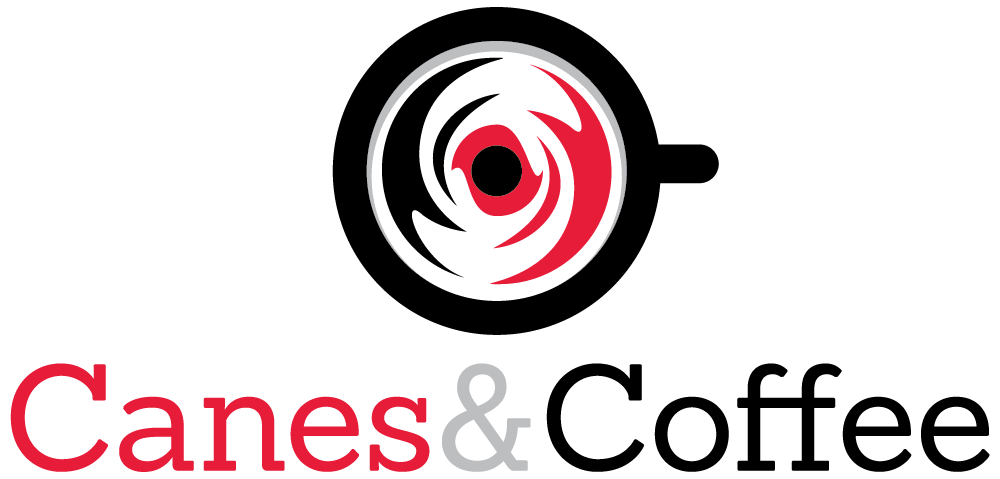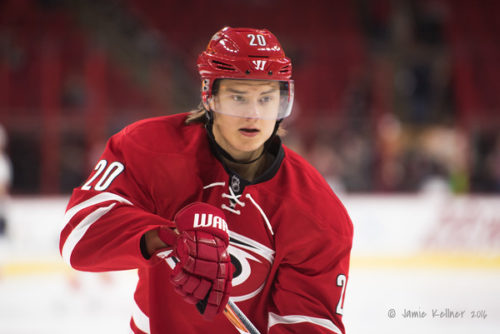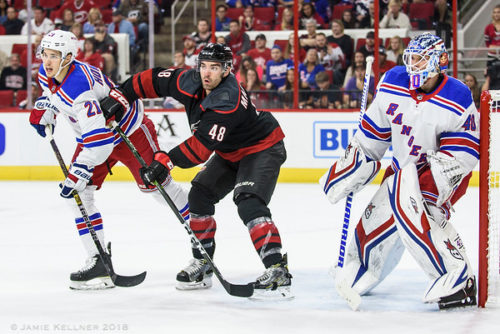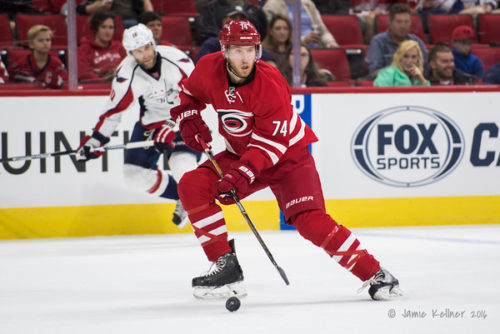In a game with significant long-term financial commitments without much for an out or any requirement for expected performance to be met and a salary cap that limits flexibility if things do not work out as planned, a significant part of roster building is or at least should be risk management.
There are many different types of risk that come into play with contracts. Simple performance risk comes into to play for both young players who maybe take a step back and also older players who fade. Some players have injury risk. And there is simple risk from term with things being increasingly less predictable the farther you go into the future.
Under the management that took the helm with the arrival of Tom Dundon, the Carolina Hurricanes very clearly get the need to consider this.
Today’s Daily Cup of Joe looks at how the Hurricanes have managed and in many cases passed on taking on risk with players/contracts.
Term and age risk
In consecutive summers, the Hurricanes chose to part ways with a top half of the roster player because management decided not to re-up for a long contract at top dollar for a player who would be into his mid-30s for the final years of the deal. Two summers ago, the Hurricanes parted ways with Jeff Skinner in a trade that netted only a collection of mid to low futures. Then this past summer, the team traded Justin Faulk again because it did not want to commit to seven years at top dollar for a contract that would stretch to Faulk’s mid-30s.
It is too early to make a final declaration on these two decisions, but early on the decisions look positive. In the first year of an eight-year contract averaging $9 million per year that stretches until he is 35 years old, Jeff Skinner has just 12 goals in 52 goals and would have to hustle to even reach 20 goals. In his first season in St. Louis with his new contract not even starting until next year, Justin Faulk has seen his scoring drop, and he is toward the bottom of the team in plus/minus.
Injury risk
The Hurricanes have also moved on from a couple quality players that carried significant injury risk. This past summer, the Hurricanes let Micheal Ferland walk to free agency seemingly without making a serious push to re-sign him. The Canes also traded Calvin de Haan after only one year in a Canes uniform after he injured a shoulder that had been a problem for him in the past.
In the first year since they departed, both of those decisions have been on target. In the first year of a four-year contract, Micheal Ferland has played only 14 games and has been ruled out for the rest of the 2019-20 due to recurring concussion-like symptoms. Calvin de Haan started well in Chicago, but only 29 games into the season, he reinjured his shoulder and is out for the rest of the 2019-20 season.
Unrealized draft pedigree risk
Another interesting category of risk is the risk that comes with signing young players who have not yet peaked to pricey, long-term contracts that sort of assume that the player’s high-end potential will be reached. Increasingly, in today’s NHL players coming off entry-level contracts are signing long-term deals for full value. If the player does not grow into that full value, the salary can be too high for the player’s role and/or level of production.
I think Elias Lindholm and Noah Hanifin fit into this category when they were traded. Both players were coming off of modest contracts both in terms of salary and term and looking for a next contract that was more dollars, longer term and therefore higher risk. Hanifin was still living largely off a draft pedigree and potential as a player who was a third pairing defenseman the prior season. Lindholm had established himself as a capable middle six forward, but it was not clear if his ceiling was much higher than that. When neither player was willing to settle for less, they were shipped out together in the trade for Dougie Hamilton. Lindholm ultimately signed a new contract for six years at $4.85 million per year, and Hanifin signed for six years at $4.95 million.
Fast forward to today, and I would say that the Canes went one out of two on the pair. Hanifin has played some in Calgary’s top 4, but I am not sure he is really more than a #4/#5 type. Lindholm has thrived as a goal scorer primarily playing on Calgary’s top line. He had 27 goals and 78 points in a break out 2018-19 season, and though his point total is tracking a bit lower in 2019-20, he has already matched the 27 goals.
The often treacherous unrestricted free agent market
Arguably what the Hurricanes have not done could be the team’s greatest risk mitigation. The Hurricanes have steered clear of the long-term, expensive contracts that often get handed out during the peak of free agent signing season. The Hurricanes signed Petr Mrazek for only two years last summer and in the process passed on pricier options. And the Hurricanes have avoided risky, long-term deals for unrestricted free agents.
A recent shift?
Interestingly, the Hurricanes took on two players at the trade deadline that I think carry a bit more risk. Vincent Trocheck has had two leg injuries recently. His contract has only two years remaining, so the injury risk is mitigated to some degree. The Hurricanes also added Brady Skjei who has four years remaining at $5.25 million per year. The risk with Skjei is that his contract is a bit inflated for his level of play. But I guess the flip side is that Skjei looks a bit like Hamilton as a defenseman who can skate and has the physical tool set but has some detractors in terms of his defensive play.
What say you Canes fans?
1) Do you agree that the Hurricanes have made a concerted effort to avoid taking on risky contracts?
2) Who has other examples of where the Hurricanes avoided risk?
3) Do you think the acquisition of either Brady Skjei or Vincent Trocheck was a diversion from a previous strategy of mostly avoiding risk?
Go Canes!




1) I don’t think so.
2) None—but they accepted risk in acquiring Gardiner for 4 years. There was also the small risk of Haula’s health. So a complete picture doesn’t fully support the idea that management is considering risk. All of us thought heading into last season with Mrazek and Darling was a huge risk. There were lesser concerns about Mrazek and Reimer this season.
3) I think management is doing an average job. While it is not a simple binary strategy, I think they are much too reluctant to bring up players. The Canes iced Trocheck and Skjei and lost. Meanwhile, Florida won with Saarela and Wallmark in the lineup, the Rangers are undefeated since Gauthier entered the lineup, and Vegas is something like 14-8 in games where Roy played. I readily admit that none of Saarela/Gauthier/Roy have been hugely productive, but the argument was always that the Canes couldn’t “risk” having unproven players in the lineup. Some here at C&C have argued that management was correct in trading and/or not calling up prospects because they weren’t playing elsewhere. Though a small sample size, the last few weeks undermine both arguments. (Ironically Skjei’s misplay and Trocheck’s penalty did partially cost the Canes a game in the standings).
Of course, this is a much deeper discussion. But my point is that the Tampa model is working much better than the Nashville model (Duchene, Turris, Johansen providing perhaps the best center depth acquired by any team).
The thought process on Lindholm was completely wrong. Among Gardiner, Hanifin, Skjei there is a decent case that Hanifin is on the best contract.
All the actions make me think there is an unspoken bias for players acquired by the current management, or perhaps a bias against players drafted by Francis’ team. Because outside of Aho, Necas, Fleury (a prime example of mis-development) and Foegele there are none remaining in Raleigh. I don’t ascribe to the argument that the Aho negotiation was based on a winning strategy as there is logic that says both Point and Laine signed equally good deals. Neither Bean nor Geekie has been utilized.
This bias has spread to the fan base. The prime example is that Kochetkov is widely thought to be the best goalie prospect despite being the third best goalie based on statistics on all four of his different teams this season. Meanwhile, Makiniemi who is only two months older is treated like an afterthought despite leading an entire league in sv% and overall wins. Additionally Makiniemi has performed as well as a prospect considered in the top 10 among all goalie prospects (Dostal) in Finland’s top league.
There seems to be a bit of groupthink setting in. That often ends poorly.
One of the best examples of groupthink I’ve seen is fans believing that all, or most, of their AHL players are going to be solid NHL players. Evidence is strong against that idea. Even relating scoring at the AHL level to the NHL level is a huge mistake.
What fans don’t know about what’s going on behind the curtain is huge. All these people we talk about are human beings, not robots. They have positive and negative characteristics that can’t be measured in data. Often you hear later that a guy is lazy, out of shape, can’t grasp the systems, selfish, etc. No organization is going to broadcast that kind of information for obvious reasons.
The best evidence that the Canes are managing their prospects adequately is those that have left have made little to no impact in the NHL.
Good call on Gardiner. I should have included him. He was coming off a back injury that could have long-term effects and though the price was somewhat discounted, the 4-year term did come with risk.
I thought of Haula but intentionally did not include him only because the modest salary and 1-year term minimize it.
1. I think management has done an excellent job including risk – primarily contract risk – in it’s decisions. We are not signing players to inflated contracts – Faulk and Skinner – nor are we offering “silly money” at a UFA. Although the Gardiner decision may not prove to be a good one it is only a $4M contract.
We will never know what was going on behind the scenes with Ferland. I understood it was about term but I don’t think health was the primary risk factor we looked at, but rather salary/cap flexibility 2+ years out. It is hindsight to say no signing Ferland was effective injury risk mitigation – it we more a matter of fortune.
As for CdH, we didn’t move him because of injury risk – his trade was a salary dump so we wouldn’t find ourselves in a pinch if MTL showed up with a monster offer sheet for Aho (although his shoulder may have made him our first choice of player to be moved). And Saarela was the sweetener (thanks, ct, for mentioning he is getting NHL ice time with FLA – 2 goals in the 4 games since he was called up; glad to see him getting the opportunity now). Again, for it to appear risk avoidance is an exercise in hindsight.
2. I will have to think about this.
3. No. I think Trocheck was the right pickup – a productive 2C (long identified as a need) for a rental, a replaceable 4C, and a couple of prospects who weren’t going to be NHL gamechanger. I don’t see the risk here.
And I think there is a bigger picture behind our pickup of Skjei – one that involves limited tenure for Gardiner and the risk we don’t come to terms with Hamilton.
But both players are important for this year’s success, which would mitigate any other risk.
AHL players are affordable, driven and low risk. A successful callup can contribute significantly on what amounts to entry level contract money.
A “proven” inconsistent defenseman on a longterm contract is the much greater risk.
I think the Canes’ propensity to not give their pipeline players a chance to prove themselves at the NHL level is a huge risk.
The Haula trade was a bust, as evidenced by him being traded again. Roy is proving to be a solid (if not spectacular) 4th line center with size and strength, something the Canes could use to trade away Jordan Staal’s contract and hit a bigger reset button.
Hannifin is on a better deal (for performance) than Gardner, and the team could’ve used Lindholm (better than Haula or RDZ or Nino).
It’s true that fans may overvalue their own AHL players, but it’s equally true that the team really hasn’t given any of this year’s trade bate players a chance to prove themselves.
Gauthier had a small set of games earlier and looked promising, Aho and Necas both needed more than a handful of games to contribute on the scoresheet, we don’t complain about them in the lineup today.
Kuakonen had a small audition last year which was not successful, but in preseason last year playing with Jordan Staal that line seemed to be on fire. This would’ve been a good time to bring him up and see if magic could be repeated.
Neither Pesce nor Slavin looked like top 2 defensemen in their first 4 games in the NHL, but they are the reason the team’s D turned from weakness to strength (when healthy).
Yet, this year, we keep bringing in players of questionable talent, lack of compete and fraud with inconsistency from other teams giving up our own futures and picks to do so. This is beginning to feel like Rutherford era signings/dealings (Semin, Kaberle), players with “comfy” contracts and nothing to compete for.
I also think that it’s not good to develop a reputation as a team that does not give players a career success path. Kids who are drafted want to play on the big stage, they will want to be drafted by a club that rewards kids with sufficient talent and hard work with a chance at just that. I think the Canes organization is developing a reputation for over ripining players.
Just look at Fleury’s (and now Jake Bean’s) case.
I remain not a fan of this strategy and I think it’ll hurt the team in the long run.
As always, I’d rather be wrong when it means the Canes are better.
I wouldn’t get so excited by Roy. He’s in the lineup for Vegas because Alex Tuch is out. He’s been bounced up and down recently to the AHL with the reasoning that he stay playoff eligible for the Wolves. Tough to equate that to a replacement for Jordan Staal.
The players that show the ability to play in the NHL for the Canes have stuck here. Aho, Necas, Wallmark, Foegele, and Fleury have all gotten their shot. Honestly, other than a few drives to the net by Gauthier what has he done? Is he good in his own zone? Nope. Does he create offense for others? Nope. Does he play a hard game on the forcheck? Nope. His interview before the Ranges played the Canes told me he still doesn’t get it. He said he never got a shot with the Canes. Maybe he never earned the shot? Maybe he didn’t take the coaching he was given? Didn’t learn the things they needed him to learn? Scoring goals in the AHL is nice, but Gauthier needed to play a more complete game. He didn’t. Guys like Necas and Svechnikov are far more talented and you can put up with them learning on the job. Gauthier doesn’t have that luxury, and if he doesn’t start earning it with the Rangers he’s going to be right back in the AHL. Averaging 5-7 minutes a night isn’t a good sign so far. Maybe they aren’t going to give him a “shot” either.
Eklund rates the Canes among the deadline deal losers:
https://www.hockeybuzz.com/blog/Eklund/3-Losers-of-the-Deadline-New-Projected-Standings-Picks-added/1/104499
(granted that a. he’s not reliable and b. he has always had a bit of a bias against the Canes).
I don’t necessarily agree with him, but I think Lenner would’ve been a better pickup than Brady with a first round pick.
So here is one part of the deeper discussion. If you consider Trocheck and Skjei major acquisitions, then who are some comparables? I would think most would agree that Coleman to TB and Zucker to Pittsburgh. Since acquiring Coleman TB is 0-3 and Pittsburgh is 3-4-1 since picking up Zucker. Both those teams will be fine as they had playoff cushions. How would either of those results be for Carolina—the Canes would need to finish something like 12-6 or 10-3. New additions sometimes cost the team wins as they are adapting.
If you think about the Canes adding two key players, then the closest example is Columbus last season. In Duchene’s first 10 games the Blue Jackets broke even. However, they had 22 games to right the ship. If the Canes play .500 hockey for 10 games, then only 11 games will remain. So while most fans are praising the “commitment” to the playoffs, there is actually a significant amount of evidence that suggests the Canes might be risking the playoffs.
The move that we all liked (yes I thought it was brilliant) was acquiring Niederreiter. However, I think this year paying $5.25 for 36 points is close to an “inflated contract.” I know he replaced Rask. Even Rask is on pace for 23 points, kills penalties, and has committed far fewer costly penalties. So again, not really superior to any other NHL management team.
As far as AHL talent. My guess is Tampa fans don’t believe “most” prospects in the organization will make a difference in the NHL. But enough have that they had exactly one forward (the cheaply acquired Maroon) that was drafted or an unsigned free-agent before acquiring Coleman and Goodrow (which has allowed them to have a losing streak). There are other teams competing with Carolina for a playoff spot that are relying on call-ups. Philadelphia is getting contributions for Aube-Kubel; Columbus form Stenlund, Robinson, and Bemstrom; the Panthers from Stillman and now Saarela. Only Bemstrom would be considered in the same category as Gauthier/Kuokkanen.
It makes sense for teams like Pittsburgh and Tampa to make big additions: 1) they have some cushion if the new players make the team worse in the short run; 2) both are among the handful of teams that are conceivably one or two players away from winning the Cup. Maybe Carolina is in that same position.
I agree with your point about judging deadline acquisitions before they have a chance to meld with the team. You don’t know if the Canes won or lost at the deadline until the end of the season, honestly.
Dead on about Niederreiter and Rask. That trade isn’t looking as bad for Minnesota these days.
I was surprised with the Skjei trade. Gave up a lot for him. If he plays well and stays in the top 4 then it was worth it. We may not know that for a year or so. Looks to me like Dundon has high expectations and is willing to roll the dice on trades. Risky, but entertaining. Columbus and Florida are teams running on a budget. The Canes obviously have no budget for player salaries at this point.
As for managing injury risk, we’re going to see whether that’s a real thing because … and this may be unpopular: Pesce has injured a shoulder twice now and has a lot of term left. Maybe he’s the defenseman that gets moved out this offseason in exchange for a premium player of his quality.
He’s going to have very high value – very high – so if there was ever a time to sell high … just saying. You heard it here first.
Woof. Outside the box thinking there. I think you wait and see with someone as good as Pesce. Guys like that are hard to find and even harder to get to sign in Carolina.